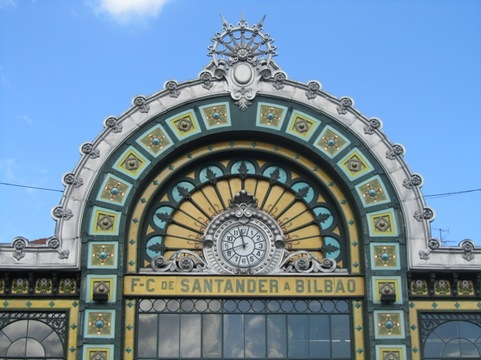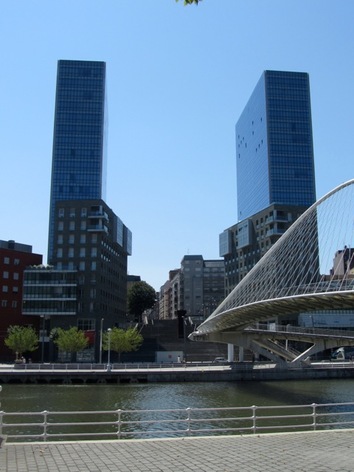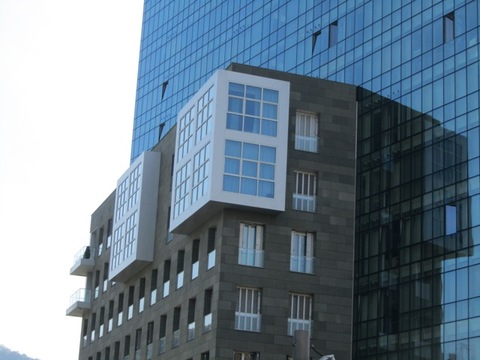Moon above the Guggenheim, September 2012
I very often wake up with a song or a tune in my head and start singing it. I know most people would find that hard to live with, but Pietro amazingly doesn’t mind. Today it was ‘Blue Skies’ by Irving Berlin, which we ended up listening to (thanks to Spotify and Doris Day) over breakfast.
Perhaps my subconscious turned ‘Blue Skies’ up because of the great weather we’ve had here over the last two months. There has been some rain, and a few very grey days, but not as much as we’d expected, given Bilbao’s reputation for rainfall (50% more on average than in Oxford) – though October to April is when we can expect most rain, apparently.
Last week, the temperatures dipped down to something that felt a bit like it might be approaching autumn (I actually had to put a pullover on one evening at about 11pm!), but currently it’s hot again.
There are, it seems, two kinds of weather in Bilbao: shining blue skies and glowering grey skies, and not much in between. If the sky is blue or grey in the morning, it will almost certainly stay that way for the day. Rain when it comes, is not generally heavy – it’s usually drizzle: they use the lovely word ‘sirimiri’ for it here. But so far, it’s mainly been blue skies, and they are spectacular, set against the green hills and river valley of the city.
The only thing is that I don’t get to see those blue skies that much. The Casco Viejo, where we live, is lovely – atmospheric, full of life, old – but it’s also dark and cold. Narrow, densely built medieval streets with six storey buildings don’t allow the sky much of a look in. This can be a huge advantage when the weather is hot. When it was 40 degrees and blazing hot, you only had to dive into the streets of the Casco Viejo to escape the heat, and our flat was a refuge.
So getting out to explore the city at weekends and in the evenings is when I get to see the skies and be dazzled by light. Bilbao is not a classically beautiful city, but when the river sparkles and the hills and buildings shimmer beside it, the beauty it has is very striking.
The time I most enjoy the Bilbao setting – the skies, the hills, and the river – is when I go for my run in the mornings. This takes me through town along one bank of the river, then back along the other bank, and it’s a really inspiring route, My run in Oxford was also a lovely route along the river – down to Iffley and back again, always with the reward of seeing one of the most beautiful Norman churches in Britain at the half-way point of the run – but this is quite different: a much more urban route, but surrounded by green hills.
I start off by the beautiful 15th century church of San Anton by the river at the bottom of our street, which is where Bilbao began. There was a church here long before Bilbao was founded in 1300, with a small fishing village on the other side of the river. Until the nineteenth century, this was the centre of the town, rather than the outpost that it now is.
I run over the old bridge (originally the only bridge in Bilbao, but now there are about ten in Bilbao itself and two more between Bilbao and the sea), and down the river in front of a handsome group of 19th century buildings (now mostly flats and offices, but I imagine some of them were warehouses originally).
The path strays briefly from the river a little after this, up a little hill where there are nice views of the river and city, to the edge of the slightly dodgy area of town called San Francisco (more on this in a later post!).
Then back down to the river and past the beautiful Art Nouveau station for trains to Santander and the north coast. (In Spain, ‘Art Nouveau’ is confusingly known as ‘Modernisme’, by the way.)
Now, back onto the riverside path, alongside the new tram-line, with an excellent view of the19th century ‘Ayuntamento’ (Town Hall) on the opposite bank.
The bend in the river here takes you into the area known as Abandoibarra (‘Abando Valley’, Abando being the name for the area on which Bilbao was built). Abandoibarra is the riverside port and ship-making area which went into a catastrophic decline in the 70s and 80s. In the 90s, it was levelled and rebuilt with the Guggenheim and other architectural projects (see www.bilbaointernational.com/en/abandoibarra- I’ll write more on this in a later post).
I cross the river, either on the lovely new pedestrian bridge known as ‘Zubizuri’ (‘White Bridge’), designed by the Spanish architect Calatrava,…
... or on the interesting but less immediately attractive pedestrian bridge down by the Guggenheim, the ‘Puente Pedro Arrupe’,, the latter of which gives excellent views of the museum, and down towards the sea, 10 miles away.
And then back along the other side, below Mount Artxanda (up which one can take a funicular railway for an amazing view of the city – more in a later post). From here, one gets great views of one of Bilbao’s other grands projets of regeneration, the Isozaki Atea. (‘Isozaki’ is the name of the Japanese architect, and ‘Atea’ means ‘Gate’).
The project, built inside the shell of an old 19th century customs building, has at its centre two imposing and rather beautiful skyscrapers which form a gateway from the river and the Zubizuri bridge to the ‘Ensanche’ (new town) behind Abandoibarra. There’s an impressively monumental stone staircase up from the river to the hill behind. At the top of the steps, there’s a sculpture by the Basque Country’s most celebrated artist, Eduardo Chillida. The skyscrapers themselves are interesting in the way they echo the enclosed balconies of 19th century Basque domestic architecture. (We reckon that these balconies must have developed here because there is so much rain.)
My run continues past the town hall and into the ‘Arenal’, between the river and the Casco Viejo, Until the 19th century, the Arenal was an area of sandy ground in the bend of the river. (I hadn’t realised that the original meaning of the word ‘arena’ in Latin was ‘sand’; an ‘arena’ as a place of competition was a ‘sandy place’.) It’s now an elegant tree-filled ‘plaza’ with the church of San Nicolas on one side and an Art Nouveau bandstand by the river – built over a century ago for the Bilbao Municipal Band, and still used by it for Sunday afternoon band concerts (and a superb band it is too.)
The Arriaga Theatre stands grandly at the end of the Arenal. (Arriaga was a 19th century Spanish composer (from Bilbao), one of the few whose music became known internationally.) This is the city’s main theatre, but the space outside is also where the Fiesta is launched, and where public gatherings of various kinds are held.
I run on past the theatre and on to ‘La Ribera’, the recently restored and modernised market building of about 100 years ago. It’s one of the biggest indoor markets in Spain, built on the city’s medieval market place – next to San Anton church, where my run started.
And so back into the tall, dark, atmospheric alleys that make up the ‘Siete Calles’ of the Casco Viejo.






























 RSS Feed
RSS Feed